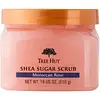What's inside
What's inside
 Key Ingredients
Key Ingredients

 Benefits
Benefits

 Concerns
Concerns

 Ingredients Side-by-side
Ingredients Side-by-side

Sucrose
HumectantGlycerin
HumectantPolysorbate 20
EmulsifyingSilica
AbrasiveParfum
MaskingOenothera Biennis Oil
EmollientPersea Gratissima Oil
Skin ConditioningRosa Canina Fruit Oil
EmollientArgania Spinosa Kernel Oil
EmollientPrunus Amygdalus Dulcis Oil
Skin ConditioningButyrospermum Parkii Butter
Skin ConditioningCarthamus Tinctorius Seed Oil
MaskingCitrus Aurantium Dulcis Oil
MaskingMacadamia Ternifolia Seed Oil
EmollientRetinyl Palmitate
Skin ConditioningAscorbic Acid
AntioxidantPhenoxyethanol
PreservativeCaprylyl Glycol
EmollientSorbic Acid
PreservativeBlue 1 Lake
Cosmetic ColorantCI 14700
Cosmetic ColorantSucrose, Glycerin, Polysorbate 20, Silica, Parfum, Oenothera Biennis Oil, Persea Gratissima Oil, Rosa Canina Fruit Oil, Argania Spinosa Kernel Oil, Prunus Amygdalus Dulcis Oil, Butyrospermum Parkii Butter, Carthamus Tinctorius Seed Oil, Citrus Aurantium Dulcis Oil, Macadamia Ternifolia Seed Oil, Retinyl Palmitate, Ascorbic Acid, Phenoxyethanol, Caprylyl Glycol, Sorbic Acid, Blue 1 Lake, CI 14700
Water
Skin ConditioningCetearyl Alcohol
EmollientKaolin
AbrasiveHydrated Silica
AbrasiveGlycerin
HumectantStearic Acid
CleansingCaprylic/Capric Triglyceride
MaskingButyrospermum Parkii Butter
Skin ConditioningParfum
MaskingCocos Nucifera Oil
MaskingBambusa Arundinacea Stem Extract
Skin ConditioningZiziphus Jujuba Fruit Extract
Skin ConditioningNelumbo Nucifera Flower Extract
Skin ConditioningBisabolol
MaskingEthylhexylglycerin
Skin ConditioningTocopherol
AntioxidantDisodium EDTA
Xanthan Gum
EmulsifyingSodium Cetearyl Sulfate
CleansingSodium Stearoyl Glutamate
CleansingSodium Stearoyl Lactylate
EmulsifyingPolyacrylamide
Water, Cetearyl Alcohol, Kaolin, Hydrated Silica, Glycerin, Stearic Acid, Caprylic/Capric Triglyceride, Butyrospermum Parkii Butter, Parfum, Cocos Nucifera Oil, Bambusa Arundinacea Stem Extract, Ziziphus Jujuba Fruit Extract, Nelumbo Nucifera Flower Extract, Bisabolol, Ethylhexylglycerin, Tocopherol, Disodium EDTA, Xanthan Gum, Sodium Cetearyl Sulfate, Sodium Stearoyl Glutamate, Sodium Stearoyl Lactylate, Polyacrylamide
 Reviews
Reviews

Ingredients Explained
These ingredients are found in both products.
Ingredients higher up in an ingredient list are typically present in a larger amount.
This ingredient is also known as shea butter. It is an effective skin hydrator and emollient.
Emollients help soothe and soften your skin. It does this by creating a protective film on your skin. This barrier helps trap moisture and keeps your skin hydrated. Emollients may be effective at treating dry or itchy skin.
Shea butter is rich in antioxidants. Antioxidants help fight free-radicals, or molecules that may harm the body. It is also full of fatty acids including stearic acid and linoleic acid. These acids help replenish the skin and keep skin moisturized.
While Shea Butter has an SPF rating of about 3-4, it is not a sunscreen replacement.
Shea butter may not be fungal acne safe. We recommend speaking with a professional if you have any concerns.
Learn more about Butyrospermum Parkii ButterGlycerin is already naturally found in your skin. It helps moisturize and protect your skin.
A study from 2016 found glycerin to be more effective as a humectant than AHAs and hyaluronic acid.
As a humectant, it helps the skin stay hydrated by pulling moisture to your skin. The low molecular weight of glycerin allows it to pull moisture into the deeper layers of your skin.
Hydrated skin improves your skin barrier; Your skin barrier helps protect against irritants and bacteria.
Glycerin has also been found to have antimicrobial and antiviral properties. Due to these properties, glycerin is often used in wound and burn treatments.
In cosmetics, glycerin is usually derived from plants such as soybean or palm. However, it can also be sourced from animals, such as tallow or animal fat.
This ingredient is organic, colorless, odorless, and non-toxic.
Glycerin is the name for this ingredient in American English. British English uses Glycerol/Glycerine.
Learn more about GlycerinParfum is a catch-all term for an ingredient or more that is used to give a scent to products.
Also called "fragrance", this ingredient can be a blend of hundreds of chemicals or plant oils. This means every product with "fragrance" or "parfum" in the ingredients list is a different mixture.
For instance, Habanolide is a proprietary trade name for a specific aroma chemical. When used as a fragrance ingredient in cosmetics, most aroma chemicals fall under the broad labeling category of “FRAGRANCE” or “PARFUM” according to EU and US regulations.
The term 'parfum' or 'fragrance' is not regulated in many countries. In many cases, it is up to the brand to define this term.
For instance, many brands choose to label themselves as "fragrance-free" because they are not using synthetic fragrances. However, their products may still contain ingredients such as essential oils that are considered a fragrance by INCI standards.
One example is Calendula flower extract. Calendula is an essential oil that still imparts a scent or 'fragrance'.
Depending on the blend, the ingredients in the mixture can cause allergies and sensitivities on the skin. Some ingredients that are known EU allergens include linalool and citronellol.
Parfum can also be used to mask or cover an unpleasant scent.
The bottom line is: not all fragrances/parfum/ingredients are created equally. If you are worried about fragrances, we recommend taking a closer look at an ingredient. And of course, we always recommend speaking with a professional.
Learn more about Parfum